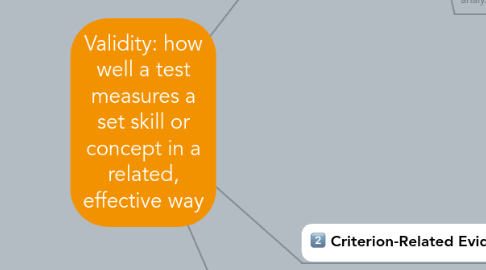
1. Content Evidence
1.1. Simplest process that can be used to check for validity
1.1.1. Recruit Project Sponsor
1.1.2. Recruit Project Manager
1.1.3. Review Related Projects and Lessons Learned
1.1.4. Prepare Project Initiation Plan
1.1.5. Brief the Initial Project Team
1.1.6. Review Project Kick-off Plans and Presentation Map
1.1.7. Hold Project Kick-off Meeting
1.2. Better if used for areas of subject achievement rather than personality traits
1.2.1. Establish Project Objective
1.2.2. Establish Project Scope
1.2.3. Map Requirements
1.2.4. Map Solution
1.2.5. Map Training Requirement
1.2.6. Review Project Scope
1.3. Teacher must inspect test questions in order to verify that it covers what the students expected, as it corresponds to the contect taught
1.3.1. Determine Project Approach, Stages and Steps
1.3.2. Estimate Project Duration
1.3.3. Establish Resource Requirements
1.3.4. Prepare Project Schedule and Budget
1.3.5. Prepare Work breakdown structure
1.3.6. Document Success Criteria
1.3.7. Review Project Schedule
1.4. "Content validity evidence answers the question 'does the tst measure the instructional objectives?' " (Kubiszyn & Borich, 2010, p. 330).
1.4.1. Identify Project Resources
1.4.2. Recruit Project Steering Committee
1.4.3. Recruit Project Coordinators
1.4.4. Identify / Recruit Key Stakeholders
1.4.5. Determine Training Requirements
1.4.6. Map the Project Organization Chart
1.4.7. Review Project Organization
1.5. One issue: modality of the test can also measure unexpected skills, such as reading, guessing, or matching ability, that will go unidentified when using content validity. This method ONLY analyzes the content of the subject matter.
1.5.1. Establish Project Administration Procedures
1.5.2. Establish Quality Control Procedures
1.5.3. Establish Progress Control Procedures
1.5.4. Establish Change Control Procedures
1.5.5. Establish Issue Resolution Procedure
1.5.6. Review Project Control Procedures
2. Criterion-Related Evidence
2.1. Concurrent
2.1.1. Yields a numeric value, or a correlation coefficient.
2.1.2. Assists in measuring validity of a new, or recreated test
2.1.3. "The concurrent validity evidence for a test is determined by administering both the new test and the established test to a group of respondents , then finding the correlation between the two sets of test scores," (Kubiszyn & Borich, 2010, p. 330)
2.1.4. Similar rankings per student, between the established and new tests, means a high correlation coefficient, and thus indicating concurrent validity.
2.2. Predictive
2.2.1. Yields a numeric value, or a correlation coefficient.
2.2.2. Useful for aptitude tests
2.2.3. "Predictive validity evidence refers to how well the test predicts some future behavior of the examinees ... [or] how well test takers will do in some future setting," (Kubiszyn & Borich, 2010, p. 331)
2.2.4. Design: an initial test is administered to a group and given a score, the group is scored or graded on the same subject over time in the classroom, the two scores are correlated to generate a correlation coefficient. Correlation coefficients are used to predict future performance on the same intial test.
3. Construct Evidence
3.1. "A test has construct validity evidence if its relationship to other information corresponds well with some theory," (Kubiszyn & Borich, 2010, p. 332).
3.1.1. Prepare Product Evaluation
3.1.2. Conduct Product Evaluation
3.1.3. Initiate Maintenance Process
3.2. Test results must correspond with the teachers background knowledge of a core subjects expectations.
3.2.1. Prepare for Project Closure Meeting
3.2.2. Conduct Project Closure Meeting
3.2.3. Follow Up Project Closure Meeting
